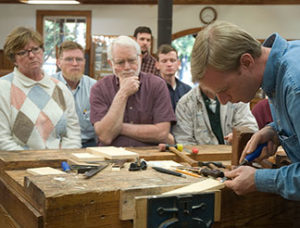
This article is an excerpt from an interview with Frank Strazza on hand tool woodworking that was featured in the January 2012 issue of our SustainLife Quarterly Journal.
Ploughshare: Can you elaborate on why you have more of a hand tool focus?
Frank Strazza: Working with hand tools really does slow down the process to where you can understand how the tools work and how the joints work. It gives you greater sensitivity to your work because when you’re working with a machine, a lot of times you’re disconnected from your work. You’ve got on all the safety equipment—ear protection, eye protection, dust protection—which tends to disconnect you from what you’re doing. You don’t experience it the same way as you can with hand tools.
When I’m working with a hand tool, there’s a whole different feeling. When I teach woodworking, I try to get students to listen to the sound of the plane when it’s going through the wood. They learn to feel how much or how little pressure to apply. They have to look, and see, “Oh, the shaving’s thicker on this side, and it’s not as thick on this side.” They have to feel the blade protruding. “Is it coming out more on this side?” So they’re using their senses. They’re smelling the wood; they’re experiencing it. You get to experience the work in a totally different way, a way that you don’t with power tools.
And what’s interesting is, a lot of times, people have a misconception about hand tools: that it’s a slow, archaic way of doing things. It’s not that hand tools didn’t work, but they just didn’t keep pace with the industrialization of society. So hand tools slowly fell by the wayside, and power tools took their place. And also, what a lot of woodworkers do is set up a mini-factory in their garage. But I find that many students say, “This is what I want to do. Hand tools are just so much more enjoyable”. You can do that in a small space, and it’s safe. You can still get cut with a hand tool, but it’s going to be far less severe than if you were to get cut with a machine.
A couple of weeks ago, we had a workbench class, and one of my students was hand planing the top of his workbench. Just imagine, this is a hard maple top, and it’s 31 inches wide and seven feet long, and he’s been planing it for quite some time. Someone walks in and says to him, “Well, what is that? That probably takes at least twice as long to do it by hand doesn’t it?” And I kind of just laughed inside because he’s missing the whole concept here. There are some things that the best way to them is by hand. All woodworking can be done totally by hand. Only part of it even can be done with a machine. If your aim is to mass produce something, it may be worth it to set up a machine that can efficiently mass produce it, but the finest pieces of furniture that were ever built during the seventeenth, eighteenth and nineteenth centuries were done entirely by hand.
I don’t mind using power tools for rough stock removal, but hand skills are necessary to do the finer joints and the finer details, such as the hand planing of the top. The truth of it is, there really would’ve been no mechanized way to flatten that workbench top without a huge industrial machine that very few shops could even have. It would have to be something big enough to run the top through, in order to get it perfectly flat. But a hand plane will do it; it’ll get the top perfectly flat.

Fantastic article for understanding the woodworking experience. Society today is fixated on the production process to the point “less enjoyment”. I have only attended 2 classes at your school (working with hand tools.. the class about hand planes). Those 2 classes have given me the basic tools to move forward in my own “skill development”. The total sensory involvement of the woodworking process is what gives me the satisfaction I am looking for in this endeavor. I am always impressed with the experiences I have had with Frank and all the staff of the school.